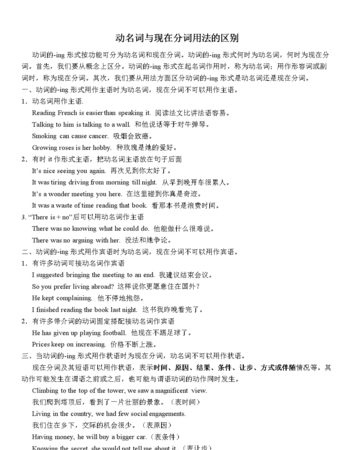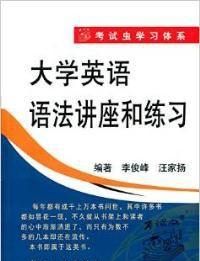本文目录
英语现在分词的变化规则是什么
分词可以和be动词,在句子中做谓语,构成进行时态。
不作谓语时,
分词(包括现在分词和过去分词)主要起形容词和副词作用,在句中充当表语、定语、宾语(或主语)的补足语和状语等。
1) 作表语。这时,现在分词常常表示特性,过去分词表示状态。例如:
His argument is very convincing. 他的论点很令人信服。
They were very excited at the news. 听到这个消息,他们非常激动。
【注】注意不要将作表语的分词和构成进行时态和被动语态的分词混淆起来。试比较:
a) The present situation is encouraging. (分词作表语)当前的形势令人鼓舞。
The present situation is encouraging us to continue our experiment. (分词构成进行时)当前的形势正在鼓舞我们继续试验。
b) The cup was broken. (分词作表语)杯子破了。
The cup was broken by John. (分词构成被动语态)杯子是约翰打破的。
2) 作定语。例如:
Don’t disturb the sleeping child. 不要惊扰这个酣睡的孩子。
The arrested murderer will be tried soon. 那个被逮捕的谋杀者不久将受到审讯。
【注】分词作定语的位置
分词作定语时,若是单个分词作定语通常是前置修饰语(Pre-modifier),如上面例句所示;若是分词短语作定语则应置于被修饰词的后面(Post-modifier),其作用相当于一个省略了的定语从句。例如:
You may ask the lady (who is) sitting at the desk. 你可以问一问坐在桌子旁边的那位女士。
Those (who have been) elected as committee members will attend the meeting. 当选为委员的人将出席这次会议。
3) 作宾语(或主语)的补足语。例如:
He likes to sit on the beach and watch the sea gulls flying. 他喜欢坐在海边看海鸥飞翔。
The work left everyone exhausted. 那个任务使得人人疲意不堪。
【注】(1)常跟分词作宾补的动词有:
catch(偶然发觉) have(让,使) keep(使处于某状态)
get(使得) see(看见) hear(听见)
find(发现) feel(感觉到) leave(使处于某状态)
make(使) want(想要) start(引起)
notice(注意到) observe(观察) watch(注视)
set(使处于某状态)
(2)现在分词和不定式作宾语补足语在含义上的区别
有些动词如:see, hear, feel, notice, watch等既可跟现在分词也可跟不定式作复合宾语。它们之间的区别在于:现在分词着重说明动作正在发生;不定式着重说明动作的全过程。试比较:
I saw the boys climbing the wall. 我看见孩子在爬墙。
I saw the boys climb the wall. 我看见孩子爬墙了。
4) 作状语。分词作状语是中国学生学习分词用法的难点和重点。
(1)作时间或原因状语,通常位于句子前面。例如:
Hearing the knock on the door, they stopped talking.
(=When they heard...) 听见有人敲门,他们停止了谈话。
Asked to work overtime that evening, I missed a wonderful film. (As I was asked to...)
由于那天晚上被要求加班,我错过了一场精彩的电影。
(2)作方式、陪衬或结果状语,通常位于句末。例如:
They stood there waiting for the bus. (and were waiting.) 他们站在那儿等公共汽车。
The bandits fled into the mountains, pursued by the policemen. (and were pursued...) 匪徒向山里逃窜,警察在后面追捕着。
The hunters fired, wounding one of the wolves. (and wounded one of the wolves)猎人开了枪,击伤了那群狼中的一只。
5) 分词的独立结构(Absolute Participial Construction)
分词作状语时,要特别注意其逻辑主语须和谓语动词的主语一致。否则,分词必须有自己的主语。这种带主语的分词结构叫作分词的独立结构,或独立主格(Absolute Construction)(参见本讲 12.1-2-1“不定式的独立主格”)例如:
The rain having stopped, the soldiers continued their march. 雨停了,战士们又继续行军了。
The boys returned, their face covered with sweat. 孩子们回来了,满脸是汗。
【注】以下几种情况也可看作分词独立结构的演变用法:
1) 省略了分词being的独立结构。例如:
The teacher entered the classroom, a bag (being) in his hand. 老师手上提着一个包走进了教室。
He stopped and turned about, his eyes (being) brightly proud. 他停下来,四处看了看,眼睛里充满了自豪的表情。
Breakfast over, he went to his office. 吃完早饭,他就去办公室了。
2) 介词with和without引导的独立结构(Prepositional Absolute Construction),有时带有分词;有时则无分词,但也可看作省略了分词being。例如:
She left the room with the candle burning on the table. 她没有熄灭桌上的蜡烛就离开了屋子。
He wandered in without shoes or socks on. 他慢悠悠地走进来,既没有穿鞋,也没有穿袜子。
6) 作插入语(Parenthesis)
有时也称“独立成分”,其作用相当于句子状语。
Generally speaking, I prefer rice to noodles. 一般地说,我宁愿吃米饭而不吃面条。
Judging from his accent, he must be a southerner. 从他的口音听来,他一定是南方人。

什么叫现在分词作伴随状语
分类: 外语/出国
问题描述:
说得越简单越好.不要从网上弄一堆文字下来.谢谢大家!
解析:
一、现在分词
现在分词由动词加ing构成。
非谓语动词中的现在分词主要起形容词和副词的作用,在句中作定语、表语、补语或状语。
一、现在分词的两个基本特点。
1. 在时间上表示动作正在进行。例如: a developing country. 一个发展中的国家, boiling water 沸水, rising sun 冉冉升起的太阳。(试比较: a developed country 一个发达国家, boiled water 白开水, risen sun 升起的太阳)
2. 在语态上表示主动。例如: the ruling class 统治阶级, the exploiting class 剥削阶级。(试比较: the ruled class 被统治阶级, the exploited class 被剥削阶级)
二、掌握现在分词的基本功能。
1. 现在分词作定语,表示正在进行的或主动的动作。也可以说明被修饰词的性质和特征,此时可换成相应的定语从句。例如:
① There was a terrible noise following the sudden burst of light.
② He saw a flying bird and raised his bow.
③ I was satisfied with the exciting speech.
2. 现在分词作状语时,可作时间、条件、结果、原因和伴随状语,表示正在进行的或主动的动作。此时分词的逻辑主语就是主句的主语,因此要注意人称、时态和语态的一致性。例如:
① The visiting minister expressed his satisfaction with the talks, adding that he had enjoyed his stay here.
② European football is played in more than 80 countries, making it the most popular sport in the world.
③Seeing from the top of the hill, we can find that the city looks more beautiful.
3. 现在分词作补足语,表示正在进行的或主动的动作。例如:
① Soon they could see the steam rising from the wet clothes.
② The missing boys were last seen playing near the river.
4. 现在分词的独立主格结构作状语。例如:
① With his lips still trembling, he couldn't say a word.
②“ Mama! ” he cried suddenly, tears rolling down his cheeks. “妈妈!”他突然哭着喊,泪水从他的脸上流下来。(这里需要用现在分词的独立主格结构 tears rolling down his cheeks 作状语。)
③ Weather permitting, we'll go to the Great wall. 如果天气允许的话,我们就去长城。(这里需要用现在分词的独立主格结构 Weather permitting 作状语。)

英语上现在分词是什么意思
现在分词的基本用法: 现在分词表示主动的意义;表示一般性的或正在进行的动作;在表现形式上有“一般式”和“完成式”与“主动式”和“被动式”之分, 1)作表语 现在分词作表语通常表示主语所具有的特征.例如: This story is quite interesting. The journey without you will be boring. 2)作定语 现在分词可以单独作定语,也可以构成合成词作定语,但在更多情况下是分词短语作定语,包括限定性和非限定性(用逗号与其他部分分开),在意义上相当于一个定语从句.现在分词作定语通常带有主动意义和未完成意义.例如: The man following was obviously in a hurry.(现在分词单独作定语) They acted just like a conquering army.(现在分词单独作定语) Do you know the man standing over there by the door? (分词短语作限定性定语) Last night,we caught a thief stealing John’s bike.(分词短语作限定性定语) The name Nebraske comes from the Oto Indian word “ebrathka”,meaning flat water.(分词短语作非限定性定语) 3)作宾语补足语 a.表示感觉和心理状态的动词,如hear,feel,find,listen to,look at,watch,notice,observe,smell,see等词的宾语可以用现在分词作宾语补足语.例如: I noticed him slipping away before the end of the meeting. I can smell turkey roasting,and it's making me hungry. b.表示“致使”等意义的动词,如catch,get,have,keep,leave,set等词的宾语可以用现在分词作宾语补足语.例如: What I saw just now set me thinking of my childhood in the countryside. Please don't keep the machine running while you are away. 4)作状语 现在分词作状语表示主语在进行一动作的同时所进行的另一动作,它对谓语动词起修饰或陪衬的作用.这时要注意现在分词与其逻辑主语在时态和意义上的统一.例如: Rushing out of the room,he was knocked down by a car.(作时间状语) = When he rushed out of the room,he was knocked down by a car. Working harder,you will pass the entrance exam. (作条件状语) = If you work harder,you will pass the entrance exam. She sat at a window,reading a book.(作伴随状语) =She sat at a window and read a book. Having won the championship,he was awarded a million dollars.(作原因状语) = Because he had won the championship,he was awarded a million dollars. Even if taking a taxi,I will still be late for the meeting.(作让步状语) = Even if take a taxi,I will still be late for the meeting. The road is under construction,thus causing the delay. (作结果状语) = The road is under construction,and thus caused the delay. 注意,当现在分词作让步状语时,一般放在句首,常常由although,though,even if, unless等连词引入;作结果状语时,一般放在句末,前面可以加so,thus,hence,thereby等副词. 过去分词的基本用法: 与现在分词不同,过去分词表示被动的意义,表示已经完成和被动的动作.在表现形式上,只有一种形式. 1)作表语 过去分词作表语表示主浯所处的状态.用作表浯的过去分词大多来自及物动词;不及物动词的过去分词能作表语的只限于少数表示位置转移的动词,如go,come,assemble等,它们用在连系动词之后,表示完成意义,无被动意义.例如: The man looked quite disappointed. He is greatly discouraged by her refusal. His hair is nearly all gone. 已经形容词化了的过去分词大多可作表语,常见的有:accomplished,amazed,amused,astonished,broken,closed,completed,complicatcd, confused,crowded,devoted,disappointed,discouraged,drunk,excited,frightened,hurt,interested,lost,satisfied,surprised, worried等. 做定语 a) 前置定语的过去分词通常来自及物动词,带有被动意义和完成意义.例如: We like skating in the frozen lake in the winter. = We like skating in the lake which has been frozen in the winter. How many finished products have you got up to now? = How many products that have been finished have you got up to now? 来自不及物动词的过去分词很少能单独用作前置定语,能作这样用的仅限以下几个词,这时仅表示完成意义,不表示被动意义: a retired worker = a worker who has retired an escaped prisOner= a prisoner who has escaped a faded/withered flower = a flower that has faded the risen sun = the sun that has just risen a returned student = a student who has returned vanished treasure = treasure that has vanished b)用作后置定语的过去分词通常也来自及物动词,表示被动意义和完成意义.这时相当于一个定语从句.例如: Things seen are better than things heard. = Things which are seen are better than things which are heard. The lobster broiled over charcoal was delicious. = The lobster which was broiled over charcoal was delicious. 做宾语补足语 a) see, hear, feel,find,think等表示感觉和心理状态的动词可以带过去分词作宾语补足语.例如: Tom found himself involved in an awkward situation. I saw Tom dressed like a beggar in the street. Everybody thought the match lost until the last minute. d) make, get, have, keep 等表示“致使”意义的动词可以带过去分词作宾语补足语.例如: I have my clothes washed everyday. Don't get your schedule changed;stay with us in the class. He’s trying to make himself understood. Please keep us informed of the latest price. c)like,want,wish,order等表示希望、要求、命令等意义的动词可以带过去分词作宾语补足语.例如: We don't like such topics (to be) discussed in class. I wish this problem (to be) solved this week. 4)作状语 用作状语的过去分词通常来自及物动词.过去分词用作状语时,修饰主句的谓语动词,意义上相当于状语从句,表示时间、条件、原因、伴随状况等.过去分词作状语,前边往往可以加when, while, if,as if, though.一般说来,这种结构的逻辑主语必须与主句的主语一致.例如: Whenever praised,she blushes.(作时间状语) = Whenever she is praised,she blushes. United,we stand;divided,we fall.(作条件状语) = If we are united,we stand;If we are divided,we fall. Written in great haste,this book is full of errors.(作原因状语) = Because this book is written in great haste,it is full of errors. Mary was reading a love story,completely lost to the romantic life.(作伴随状浯) = Mary was reading a love story,and was completely lost to the romantic life. Although born in Germany,John lives and works in U.S.A. (作让步状语) = Although John was born in Germany,he lives and works in U.S.A. 3.分词的完成式及被动式 前面提到过,过去分词只有一种形式,所以这里所讲的完成式及被动式均指现在分词的完成式及被动式. 如果现在分词表示的是一般性动作,不表明动作的先后或与谓语动作同时发生,这时要用现在分词的一般形式.例如: Living in the downtown,we found a lot of amusements. 如果现在分词所表示的动作先于句子谓语发生,就要用现在分词的完成式“(not) having+过去分词”.例如: Having heard from my father,I was relieved. Not having received any letter from my family,I was worried. 如果现在分词的逻辑主语是现在分词所表示的动作的对象,则要用现在分词的被动形式,包括其一般形式“(not) being+过去分词”和其完成形式“(not) having been+过去分词”.例如: Upon being questioned,he denied having robbed the bank. The new method,having been widely used abroad,can increase the working efficiency. 4.分词独立结构 如果过去分词或现在分词带有与句子主语不同的主语,这就构成了独立结构,也叫独立主格结构或垂悬结构,通常在句中起状语丛句的作用,表示原因、时间、条件、方式或伴随状况.例如: The holidays being over,they began to get down to do their work again.(原因状语) = As the holiday was over,they began to get down to do their work again. All things considered,her paper is of greater value than yours.(条件状语) = All things are considered,her paper is of greater value than yours. His homework done,Johan went out to play. (时间状语) = After his homework had been done,Johan went out to play. The girl was smiling sweetly,her long hair flowing in the breeze.(伴随状语) 当独立结构表示伴随状况时,可变为由with引导的介词词组, 而表示否定意义的类似结构便可由without引导.例如上例可变为: The girl was smiling sweetly with her long hair flowing in the breeze. Without anyone noticing,I slipped out of the room. 独立结构的位置比较灵活,它可以置于句首、句中或句末.另外,独立结构中用作主语的名词之前的限定词有时可以省略.例如: The manager sat quietly in his office,(his) eyes closed. He stood in the doorway,(his) wet cloak dripping water on the rug,and waited for some sign of recognition.
详细的你可以看大法。

英语现在分词的用法详解
英语现在分词的用法:做表语、作定语、作状语、作宾补。
1、做表语:相当于形容词,表示主语的性质。
例如:He is an amusing man.他是一个很搞笑的人。

2、作定语:单个单词修饰发出该动作的名词,置于前面,短语置于后面,相当于定语从句。
例如:That must be a terrifying experience.那一定是个糟糕的经历。
3、作状语:现在分词短语可以表示一个同时发生的次要的或伴随的动作。
例如:Carrying the schoolbag, he opened the door.他打开门,背上书包。
现在分词短语还可以表示原因。
例如:Being refused, he is very sad.被拒绝了,他很伤心。
现在分词短语还可以表示时间。
例如: Be careful when you cleanning the window.擦窗的时候小心点。

4、作宾补:置于动词之后。
例如:I see something burning.我看到有些东西在燃烧。
以上就是关于现在分词的功能及用法 ,英语现在分词的变化规则是什么的全部内容,以及现在分词的功能及用法 的相关内容,希望能够帮到您。
